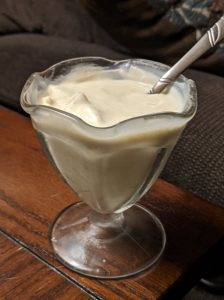At the start of the new year, one of my half-hearted resolutions to myself was to be more creative with my cooking and baking. I’ve always enjoyed working in the kitchen, but have always struggled to find what felt like the “right time” to really try out new things. In a perfect instance of be-careful-what-you-wish for, life gave me that opportunity through a pandemic and quarantine. Further inspired by dozens of hours of The Great British Baking Show, the past few months have seen me finally find that “right time” much more often.
This isn’t too revolutionary to those who know me well. In one of my firsts posts here on Concerning History, I explored one of my spectacularly underwhelming attempts to recreate a 19th century celebrity chef’s dessert recipe. In the intermittent time, I haven’t explored historical cooking as much as I optimistically concluded then, in part out of effort to refine my basic cooking skills, and in part looking for that “right time.” Over Independence Day weekend this year, though, an idea finally seemed to have found its “right time.”
During a quarantine screening of the Baking Show, Mary Berry offhandedly compared an unfortunate contestant’s custard to “a fool.” In passing, it first came across as an uncharacteristically harsh criticism—but in consideration, it brought back to my memory the “orange fool,” a very real dessert. I had first learned it existed three years ago when, like an increasingly lengthy list of ordinary things, it became the subject of political ire when living history expert John Townsend released a Youtube video featuring the dessert as he sought to recreate dishes enjoyed by George and Martha Washington. The New Yorker has a good breakdown of the whole affair—but needless to say, it is an entirely unexpected reflection of our current era of politics.
In any case, a fool is, in fact, a pudding or custard-like dessert flavored with fruit (in this case, it’s orange). And the Fourth of July seemed like a fun and fitting try to give a recipe derived from those kept by the Washingtons—both for its historical connection, but also for the pleasant prospect of a chilly fruit dessert on a hot summer day. Further, I’m a firm believer in Jean Anthelme Brillat-Savarin’s quotable claim of “Tell me what you eat, and I will tell you what you are.” Beyond health, I think there’s something said about the choices we each make about what we choose to eat, cook, and order—it’s simply a language I don’t know the words to. In making one of the Washingtons’ own desserts, then, I hoped to learn something about them—even without any precise methodology to divine knowledge out of the fool.
I used the same recipe featured in Townsend’s video, which is available freely online through George Washington’s Mount Vernon. It starts simple enough: beaten eggs, a combination of spices which would have surely been a luxury in the Washingtons’ time, and orange juice. I admit, I cheated here, taking it straight from a store-bought bottle rather than squeezing it myself. The next steps—slowly incorporating the mixture into hot cream – resembles modern custard recipes, which is what I expected going into this. Step three, however, is deceptively tricky. After ten minutes of stirring without any sign of thickening, I decided to refer to Townsend’s video—which is where I learned that, to properly thicken the Washingtons’ fool, a minimum of forty minutes of constant stirring was required. Needless to say, this was an unpleasant surprise.

After finally approaching spoon-coating thickness by the forty-fifth minute, I resorted to what Townsend deemed an unthinkable extravagance for the Washingtons, cooling the fool with an ice bath rather than allowing it to cool naturally. It was then off to the fridge to cool overnight—only to eventually reach a more-liquid-than-expected thickness closer to pudding than custard. When I was finally able to enjoy the dessert the next day, it tasted… fine? A nice, refreshing treat for a hot day to be sure, but the flavors were very subtle—and recalling forty-five minutes hunched over the pot, I’m not sure I’d call it fully worth the time.
All said, I learned more about myself than the Washingtons, first and foremost. The modern conveniences of food and cooking make strong flavors very easy to produce, with ready mixes vastly reducing cooking and preparation times. Though for the Washingtons, the fool may have been a delicious luxury, two centuries later it’s more of an archaic curiosity harkening to a bygone taste palette. Modern interpretations of the orange fool have reimagined the dessert in such a way as to do away with the entire lengthy preparation process entirely, basing the recipe on more easily prepared whipped cream and incorporating orange and lemon zest—much more strongly flavored than the juice alone.
The changes in preparation, though, are the logical outcome of societal changes since the Washingtons’ time—as it certainly wouldn’t have been George or Martha Washington stirring the fool over a fire for nearly an hour. The Washingtons’ were served by multiple enslaved cooks, who prepared the first couples’ meals under Martha’s supervision. In this sense, the fool’s tedious preparation process may be seen as a product of its original preparers, whose time and labor was at the full mercy of the Washingtons. Though the fast-paced qualities of the present day are often derided, quickly-prepared recipes are simply the products of a society where slaves, servants, housekeepers, or housewives preparing all meals is no longer the norm: where the cook simply has other responsibilities. This all isn’t to suggest, of course, that the methods of traditional cooking are entirely antiquated, or entirely the product of unequal divisions of labor. After all– the by-scratch work of a dedicated and accomplished chef or baker is miles better than what may come out of a Betty Crocker box. But, particularly when looking at historical recipes which come from social elites (which make up a large portion of those which have survived to the present day), the factor of “who was actually doing the cooking, and under what conditions” shouldn’t be ignored.
Still: the fool isn’t a bad summer treat. Undeniably refreshing, perhaps its subtle taste is more of a strength than I have given it credit for: a gentle conclusion to a rich meal, rather than the aggressively sweet flavor that many desserts bring to bear in the present day. But– the stirring. No thank you.
All said, however, it may be worth adding to the Library of Congress cafeteria menu.
